Welcome to the fourth installment of the ITD series! This time out we’re going to take a quick look at picking up orphaned teams and then we’ll delve deep into the art of assessing, rebuilding, and reloading your dynasty teams.
If you’ve missed the first three parts of this series, here’s the links:
Now that you’re all caught up, let’s talk orphans!
Orphans
What Is an Orphan?
“Orphans” are dynasty teams that have been abandoned by their original owners. They need to be “adopted” by a new owner to keep the leagues going.
Managers might have dropped the team for a variety of reasons from over-extending themselves into too many leagues to money problems or personality conflicts with other managers.
You’re going to find some orphans that are good and others that are, well, not-so-good. I adopted one last year with Saquon and Dalvin Cook, and it had been the 2nd-place team the year prior; I’ve seen other orphans left in leagues I’m in with rosters that fairly barren
Why Pick up an Orphan Team?
Orphans can present a unique challenge to veteran players or an easy inroad for newcomers. You’re going to get a roster that is different from anything you would have built; you’ll probably have players you wouldn’t have drafted. And if you haven’t worked a rebuild yet, orphans are the perfect way to try it out. It’s easy to have no compunctions about tearing a roster down when it wasn’t your build to start.
If you’re just getting into dynasty for the first time, orpahns can be an easier way to hop in. Skip the arduous thirty-round-startup and rule haggling that characterize the first months of a new league and hop into something established. Plus, it’s a great way to meet more players, and form some relationships you otherwise would not have
Finding an Orphan
Commissioners in need post orphan teams anywhere league listings can be found. There’s alway teams being posted on twitter and on Reddit. Scott Fish of Safeleauges makes a big push each spring to lock up owners for orphaned teams before the rookie drafts; you can often snag a team at a discount if your timing is right
I went a little more into detail about finding a league earlier in this series, you can jump to that article here.
Now, onto what might be the most enjoyable part of dynasty fantasy football…
The Rebuild
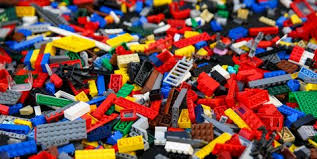
Maybe it’s an orphan you picked up. Maybe you had a run of bad injuries or didn’t do great in the draft and now you’re looking at your roster, wondering how to turn it around.
Sooner or later, every dynasty player is going to find himself starting down the barrel of a rebuild. We’re going to talk through rebuilding strategy and do’s and don’ts. But before we get into how to rebuild, we need to look at why and when we should be rebuild.
Why Rebuild?
Sure, in fantasy football, anything can happen in any given week. It’s been said that the skill is in getting your team to the playoffs, and from there it takes luck to win the ship.
But to be the 5th or 6th best team in a league and aiming to luck your way into a title isn’t giving yourself great odds. You need more than a few things to break your way; you’re relying on a series of unlikely events to co-occur.
It’s not a great bet.
You’re competing to try to win your league-mates’ money, or, if it’s a free league, bragging rights at the very least. You want to give your team the best possible odds of winning.
That means not getting stuck in the middle. It means being able to assess your team, determine a direction, and execute a plan of how to get where you want to go.
Assessing Your Team
One of the hardest things to do in dynasty is evaluating your own team. We are attached to players we like; we remember how they blew up for us two years ago or how hyped we were for them as prospects (this will be the year, Corey Davis!)
It’s hardwired into us to overestimate our own assets and to undervalue those of others.
Know when you can contend, and when you can’t.
@dynastyPhilDawg
Evaluation is also a necessity, at least if you want to be consistently competing in your leagues. We need to be able to be objective about our teams and be ruthless with our assets when it’s called for. Sometimes that means selling high on a productive vet or a popular breakout candidate; sometimes that means leveling the whole thing.
I suggest taking an actual inventory of your team. It’ll take you a couple minutes and it’s time well spent. I’m sure there’s a hundred ways to do this, but I’ll lay out some suggestions that might be helpful.
EK’s Team Inventory Cheat Sheet
Here’s an editable .PDF inventory form that you can download and use:
If you’d like to quickly read through the questions instead of using the form, here’s the gist:
- Assess your position groups in relation to the rest of the league
- You’ll get an idea of the other team’s strengths and weaknesses as well- which is important when you start making trade offers- so you’re killing two birds with one stone here
- Rank your QBs
- Rank your RBs
- Ranks your WRs
- Rank your TEs
- If IDP, rank those
- If kickers or team defense, reconsider your life choices
- Do you have position groups where you have a major advantage? Is it enough to make up for your weaknesses?
- Are there groups where you have a huge hole? What do you need to fill those gaps?
- You’ll get an idea of the other team’s strengths and weaknesses as well- which is important when you start making trade offers- so you’re killing two birds with one stone here
- How is your depth?
- Do you have bench pieces at every position to cover bye weeks and injuries?
- Do you have depth pieces that might be starters for a different team i.e. good salable assets?
- Do you have young/ascending pieces that are likely to increase in production and / or value? Examples would be 2nd-year WRs, players that broke out at the end of last year, or players whose situation has improved (QB upgrade, lost competition, etc)
- What’s their ceiling and floor?
- How confident are you in a breakout?
- What’s the consensus on these players?
- What do you have for draft capital to spend?
- What pieces do you have that are hot commodities in the community? Do you have guys that are popular choices to be breakouts or with rising ADPs?
- What pieces do you have that you are higher or lower on than are others?
- Which pieces do you have that are considered declining assets by you or by the community?
- Has their market value deteriorated already?
- How many productive years do you think they have left?
- Is your team likely to be better than last year or worse? Are your opponents’ teams likely to be better or worse?
If you went through these questions you now have a lot of information about your team. You should have an idea of where you rank in your league, and where your strengths and weaknesses lie. More importantly, you should have an idea of what you have available for assets to improve your status.
Or, You Could Take a Shortcut and Use Dynasty GM
I’m not plugging the Dynasty GM tool because I’m a good company man; I’m plugging it because it’s a great tool. One of the very many things it does well is assess your team’s strengths and weakness, much like my self-assessment tool above, without all the work.
Try it, you’ll like it.
How’s Your Team?
I want to use the information I now have and use it to drop my team in some buckets. This should inform the best direction in which to take the team.
Am I a Favorite, a Contender, Stuck in the Middle, or a Bottom Feeder?
A favorite is a top two or three team. You made a deep playoff run last year or had a clearly superior team that had some bad luck that knocked it out.
A contender is a playoff team. You’re right in the mix, and you could find yourself in the super bowl, though it would take some things to break your way.
A stuck in the middle squad isn’t terrible, but it’s not great, either. You might make the playoffs, but you’re not a real threat. You’re a .500 team.
A bottom feeder is a team that’s not likely to get many wins. It’s clear that you’re not contending.
Is My Team Ascending, Balanced, or Declining?
Ascending teams are young with many promising prospects; heavy on 1st and 2nd and 3rd year players, without many older vets.
A balanced team has a mix of youth and vets. It won’t neatly fit in either bucket.
Declining teams aren’t bad teams, but they are heavy on older players. The core of the team is past the median age for the league; 25+ y/o RBs, 27+ y/o WRs, 34+ y/o QBs, or there are many players likely not to have many years left (running QBs, guys with recurring injuries, etc)
Am I Asset Rich or Asset Poor?
An asset rich team has multiple future picks, depth pieces, or valuable young pieces to trade.
An asset poor team lacks depth or has depleted future picks.
To put together a coherent strategy, you need to know where your team lies on all of these spectrums.
Which Way Is Up?
Your path forward is going to differ depending on where you landed in those buckets. Let’s look at some team types and talk strategies, then we can talk more down-and dirty rebuilding tips.
Favorites
Your team is a beast. Good job.
I’m still trying to improve these teams- you know your opponents are as well, so you’d better keep up.
If I’m asset rich, I’m likely moving those pieces to lock down any holes I might have or to add pieces to get over the top. I’m taking deals on currently productive players where I can.
If I’m ascending, I might be holding tight; if you have excess draft capital you can use it to shore up any injury holes in-season or to take advantage of a fire-sale if one happens. Be patient!
If my team is declining, I’m probably trying to extend my window, though I might also be trying to to shift pieces around and get younger. Mostly, these are “reloading” type moves.
Contenders
These are the teams that probably need some moves to get to the next level.
If your team is ascending and asset-poor, you might be good holding steady and letting your rising stars carry you upward.
If you’re declining, you might have a tighter window; you’ll probably need to be a little more active, either to acquire some youth while still staying in the mix or to load up on easy-to-buy vets and push all the chips in.
Either way, if I’m asset-rich, I’m spending those assets to get to the ‘ship. These are the teams on which it’s worthwhile spending that future capital to make a move.
Stuck in the Middle
These are the teams that make for tough decisions.
If your team is ascending and asset rich, it’s smart to stay the course. Hang in there, be patient with the rebuild. If you try to push it too fast you can come up short. Make smart moves. Make your picks or invest in young assets that can be acquired cheaply, like young players coming off a rough year due to injury or rookies who have been slow to break out.
If your build is more on the declining side or even balanced- unless you’re absolutely loaded with assets- you should be giving serious thought to breaking it down.
Bottom Feeder
Hopefully, if you’re in this category, you’re already early in a rebuild.
Maybe you just had a bad startup draft or some brutal injury luck.
Either way, your path is simple: you’re working a full rebuild strategy.
Rebuilds & Tanking
You need to understand the rules of your league.
Some leagues have by-laws against “tanking.” Good by-laws will define what that means; usually, it will say that you can’t deliberately bench your best players or something of that sort. That type of rule should be clear and specific.
If it says you can’t, don’t do it. Don’t be a jerk.
If there are no such rules, you might consider benching some of the studs instead of selling them all off. This can speed up a rebuild drastically. You’ll burn a season or two at the bottom of the rankings but you’ll bounce right back if you’ve made good decisions in trades and the draft.
You still want to take a look at selling any declining assets if you can.
Tear-Downs
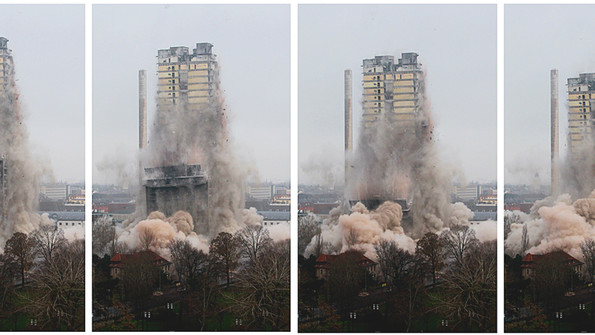
We’ll talk through a “tear-down” or full rebuild first as in many ways this is the simplest case.
In a full-on rebuild, you want to get younger and acquire future assets. You’re going to sell off veterans that don’t fit this rubric; if a player isn’t going to valuable to you in three years, they should be on chopping block.
The goal here is to stack draft picks and to set yourself up for the 1.01. On these teams, you should be making your picks and not trading them away. A couple of consecutive years of picking at the 1.01 and 2.01 and some added 1s and 2s and you’ll be right back in the mix.
Trading back from the 1.01 or 1.02 etc to acquire future firsts and current-year 2nds can be an appealing strategy.
At the beginning of the rebuild, you should be focused on assets that will hold their value for a long time. I’m going heavy on QBs and WRs. I’ll draft RBs if they are the best player available, but I’m probably trying to trade them for maximum value. RBs should be the last pieces you add; they have a short lifespan as dynasty assets.
Timing of a Rebuild
If you can pick your window, you want to start the tear-down during the season. You’ll get the best value for your players. Incite an arms-race and get the most possible compensation for your pieces.
Sell Candidates
- You should be selling off all your RBs. Sure, some RBs are hyper-productive until their late 20s or even later, but they are declining assets from their second seasons on. Also, the best way to make sure you get good picks is to slot some bums in at RB. Sell ’em off.
- You should be selling off most of your WRs that are 26 or older. Yes, those players should still be good assets for some time, but they’re likely at peak value at this point due to the typical perception of dynasty players regarding age & value.
- If selling off a stud QB can net you a trove of picks, you should do it
- If you have QBs who are in uncertain situations or who are 35 & up, you should move them
- Any players at peak value. You can’t make an omelette without breaking some eggs; you’ll have to give up some of your favorite players to succeed. Any player at peak value should go on the block.
Tips for Trading in a Tear Down
- Negotiate fair deals. Don’t announce a fire sale in chat and sell for pennies on the dollar. If you do that, you’re giving up value and prolonging your process
- Initiate trade talks.
- Find teams that have needs that your pieces fit.
- Sell your studs to competitive teams that need difference makers.
- Find teams that need depth for your bench pieces
- Remember when we looked at our leaguemate’s rosters a little earlier? You should have a good idea of who needs that RB, who needs that WR, and so on. This lets you initiate trade talks and makes it likely you’ll have receptive partners.
- Shop a player to everyone. Don’t take the first offer you get; play your leaguemates off of each other if it’s a desirable asset.
- Get players and picks instead of just picks. If you’re selling a stud, get a good young player plus picks, or high picks and a good prospect.
- Target next-year 1sts and 2nds. Ask for 3rds and 4ths as throw-ins. 3rds don’t mean much to most players, you can often get them as a freebie, and all of those picks have value to you in a rebuild
- It’s ok to target second-year-out draft picks as well.
- Ask for a 22 2nd or 3rd as a throw in.
- Get a 22 1st instead of a 21 2nd.
- You’re in a position that it makes sense to think long-term whereas your league mates are not. Take advantage of that.
Retooling and Reloading
We throw a lot of jargon around within the FF community, and a lot of it is fairly arbitrary. So let’s define these arbitrary terms:
Retooling: A significant roster restructuring that’s not a full tear- down. This is a one-year or off-seasons reworking, not a multi-year plan
Reloading: Reloading moves are moves a good team makes to get better or to prolong the competitive window
We’re talking about essentially the same processes but on a different order of magnitude. I don’t have any real “bright lines” for you here to split up rebuilding, retooling, and reloading, but it’s worth talking about them as strategies for specific team situations.
But, really, where does “reloading” stop and “retooling” start? I can’t say.
Retooling
If we’re in retooling mode, we’re probably trying to get that 7-6 or 8-5 team past the first round of the playoffs; or maybe you have an ascending team with some big holes that’s stuck in the middle or the bottom third, but that has a bright future and some nice draft capital.
You’re looking to burn assets to get your starters over the top or fill the roster gaps. You might be trying to add a few pieces in the draft as well and acquiring some extra capital to get there.
This is the type of roster work what we’re doing when we’re really one or two pieces away from a winner and we have enough assets or nearly enough assets to get there.
I have a few examples for you from my teams to illustrate what I’m talking about, and we’ll take a look at some stories that were
Team 1- A Plan Coming to Fruition
The team: This team of mine was a 2019 startup. It was supposed to be a long-term build around QBs and WRs with short term productive struggle and long term potential. It was a 2QB 3 flex 10 team league. The squad was built around Andrew Luck, Nuk, Kittle, Chris Godwin, Kenny Golladay, DJ Moore, and Cooper Kupp (0RB can be a nice dynasty build)
The problem: Unfortunately, Andrew Luck retired. Also, Kerryon Johnson was my RB1 and my RB2 was Jerrick McKinnon, who had complications in his recovery and wound up not playing in 2019.
The plan: I was ok punting 2019; as soon as I lost my 1st-rounder I felt I didn’t have much choice. The plan was to stack future assets while holding onto my WRs, get a decent draft pick, and make moves for RBs and another QB.
The moves: I had traded back for some extra draft capital to start with, and I traded away Kerryon and James White to an RB-needy teams. I traded away Nick Foles during the preseason to a team that needed a QB3 (I had some great luck dodging injury bullets after Luck).
I wound up with a niche cache of future assets and also lucked into the 1.01 (it was a lottery and I had the 3rd worst team). The Foles pick would up being the 1.03, and my other 1st was a mid-rounder. I had some 2nds already and traded Guice away before the draft for another (2.03). I traded Haskins away for Ben Roethlisberger and a 2nd..
I had picked up Minshew off waivers and I’d drafted Daniel Jones and Stafford as well, so I felt good about my QB room even without Luck. My real need was RB where I had literally nothing.
I was able to move my 1.03 and Rothlisberger to get Miles Sanders and a later first. I traded Irv Smith and a 2nd to get Melvin Gordon after the Denver signing.
I then drafted CEH, traded back into the 1.03 with two 2nds and a later first to take Taylor, and took Herbert at 1.06 to add a fourth body into my QB room (I had picked up Tyrod as well).
It wasn’t a multi-year rebuild, and I didn’t sell off my studs. I moved my valuable assets in-season to meet other team’s needs and used that draft capital to build a murderer’s row lineup in just one full season of retooling..
Here’s was the 2020 lineup:
- QB Stafford
- QB Burrow (traded away Daniel Jones)
- RB Gordon
- RB Sanders
- WR Hopkins
- WR DJM
- WR Golladay
- TE Kittle
- FLX Godwin
- FLX Kupp
- Bench: Lockett, Jonathan Taylor, CEH
I did use a short-term roster-tank by dropping all my RBs, but I hung on to my stud WRs (depsite plenty of attempts to pry them away from me). Mostly, the key strategy here was trading to meet other team’s needs.
Team 2- From the Frying Pan to the Fire
This one didn’t work out as well- I made some bad decisions! But the retooling process was fine even if my execution sucked.
The team: I picked up an orphan in a 2QB league in 2019. The roster had some big gaps but had a couple of huge studs in Dalvin Cook and Saquon Barkley. I had all my own future draft capital.
The problem: My QB2 in a 2 QB league was Derek Carr and there was no QB3. Also, my WR1 was Brandin Cooks, with Alshon Jeffrey in the WR2 spot. Behind Cook and Saquon I had Ronald Jones and Jerrick McKinnon.
The plan: Those RBs were marquee pieces; I was a little nervous about Cook’s long term health, so I was ok moving him for good value.
I needed to get a startable QB and I needed some power at the WR spot. RB depth needed addressed as well. My plan was to move a stud and some future picks to round out this roster.
The moves: I set out shopping and trying to see what I could do for QBs and WRs. The first deal I hit on I’ve gone back-and-forth on how I felt about it, but in hindsight, it was a great deal for a win-now team: I traded Dalvin Cook and Alshon Jeffrey for Julio Jones and Aaron Jones. I had Aaron Jones and Cook in the same tier and I had Julio way, way above Alshon. It actually worked out pretty well; Aaron finished ahead of Cooks and Julio was the WR6.
Getting QBs was rough in this league, and my rookie picks were late, so I didn’t think I’d be able to get one in the draft (in hindsight, I should have stayed put and taken Lock. This was my first league, so I was just learning).
I thought the best move was to overpay for a rising young stud. I’d just made the Julio trade, I knew I had a window that might not be huge, and I wanted someone that would perform now but also stick for some time. So I traded two firsts for a 3rd-year guy that many expected to take a big step forward.
Note: this part is a cautionary tale.
Unfortunately, that guy was Trubisky. Needless to say, this retooling project was not successful. The better move would have been to trade for a cheap vet or draft some second-tier QBs. Also, Saquon got hurt and Cooks disappeared.
Now I’m looking at a tear-down; the end result of a miss on an aggressive retooling project. That’s the downside of moving future picks and whiffing. You can trade yourself into a box with no good exit strategy.
Good Retooling Moves
Both of the builds above had some good examples of retooling moves.
Generally, these are the sort of things I’m trying to do in a “retooling” situation:
- selling RBs or declining assets for peak value in-season at trade deadline
- holding my WRs, QBs
- stockpiling assets to use to make a move for difference-makers
- buying undervalued / breakout candidates
- drafting immediate impact players (RBs) or trading the high draft picks for impact players
- trading for veteran QBs and veteran WRs (this type of build isn’t a great time to draft QBs or WRs)
Most of these moves are fairly common sense. The key is in diagnosing the team’s needs and assets and working with your leaguemate’s needs to get your team over the hump and into contention.
Retooling Stories From The Community
Here’s some other good retooling builds that people were kind enough to share. I love reading these- you can get an idea of what types of trades were working for these managers and the guys they were targeting to suit their plans.
This one’s from @garyhaddow1:
10tm 1tm .5ppr Orphan I got in November- worst in lg, and pick trading just started that year so people were hesitant.
— Haddow (@Haddow27) June 20, 2020
Goff/brissett for 2.02, 2.05
Edels/fitz for Arob
1.01 for Amari and Ekeler and 2.04
2.05 for Ertz
Parker for 2.01
FA adds: DJones, hurst, Gronk, stafford pic.twitter.com/xcM5WOU04P
This one by @timmymr includes all the trades he made as well, so you can see how he got from “A” to “B”
Started tearing down this dynasty team to build in the 20/21 rookie drafts, and then I got offers for Godwin and Hill haha. Team looks like it can compete in 2020, and still has 5 first round picks in 2021 (14 team) pic.twitter.com/yTmtJOOsIm
— Tim Riordan (@timmymr) June 20, 2020
Here’s another from @renshawfantasy:
Warning: Long Thread you probably won’t care about.
— Renshaw (@RenshawFantasy) May 21, 2019
Recently I joined a league a buddy of mine (@WhoIsDaveT) hosts on @SleeperHQ – podcast host league that has been really fun so far. Took over a team that @TheBackRowShow ran last year.
1/10
Reloading
Always be building! Even if your team is solid, you should always be looking to reload and refresh your roster.
These are the moves we make to keep a contender contending, to keep improving a great team. When you don’t have any real holes, it’s easy to work with what your league is giving you in terms of value to keep moving forward.
Here’s some reloading moves I made this summer to one of my best teams.
The team: Last year’s champion from my home dynasty league. The team had Kelce, Saquon, and Kamara, but was relatively weak at WR and had no draft picks for 2020 and no 1st or 2nd for 2021
The plan: I wanted to solidify my WR position and also to acquire a little more depth. I knew it was going to be tough, as I had little capital to move.
The moves: I reached out to literally every team in the league about one or two different players. I spammed trades for low value guys that might be able to help me, and tried to target trades where I could upgrade the other team at a position while upgrading me a a different spot.
I already made this into a Twitter post, so here’s what I did to remake this squad:
Always be building! A THREAD
— FFBallerEK 🦾🤖🦾 (@ekballer) June 11, 2020
I wasn't feeling so great about my championship roster from last season. It was a luck-box team, powered by the twin turbines of Barkley and Kamara, without much else of note.
I won the Super Bowl because Andy Dalton had a week 16 outburst
Good Reloading Moves
With these teams, you don’t want to fix what ain’t broken, so be careful you’re not trading just to trade.
Here’s some types of moves I’ve found successful for reloads:
- Spending future capital to shore up holes or buy discounted players
- Watching for fire sales from teammates and taking advantage of values
- 2-for-1s to upgrade a position, get a prospect thrown in
- Selling off declining assets for future assets or in packages to get an upgrade
- Selling a hyped rookie to get a proven vet
Reloading Stories From the Community
Here’s another recent “reload,” this one by @cdotFF
2QB league
— corey spala (@coreyspala) June 20, 2020
• Sent Chubb for Godwin because I knew I had the 1.04 and could snag a RB
I won the 2019 Championship – I know this is obvious and not from a mediocre team but still see how it could be considered reloading to put myself in a position for continued success pic.twitter.com/IK3PAv7Olo
Dos and Don’ts of the Rebuild
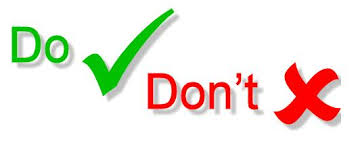
Before we get to my dos-and-don’ts, read the thread below. There are many wiser FF minds than mine, and several of them chimed in here; they said a lot of the same things I’ll tell you, and often said it better.
What is the best piece of advice you'd give to someone starting a rebuild?
— FFBallerEK 🦾🤖🦾 (@ekballer) May 24, 2020
Here’s my own list of Dos-and-Dont’s, with some quotes from my Twitterfriends:
- Do: Build around WRs and QBs. Add RBs last.
Do build around WRs, youth, the draft.
@pilotzach1
- Don’t: trade major future assets for a speculative breakout. Only target proven players when spending multiple picks
- Just ask anyone that traded for Trubisky at the peak of his hype last summer, or for Dante Pettis, or Dasvid Montgomery before he played
- Don’t: go full firesale
- One of the worst things you can do when you need to rebuild is to announce a fire sale- “everything must go”- and decide to yourself that you have sell everything on a certain day. Don’t do it!
- When your leaguemates realize you have put pressure on yourself to sell, you’re going to get lowball offers
- Don’t: give up value
- Don’t sell for pennies on the dollar! If you give away value, you’re prolonging your rebuild and keeping your team in the gutter
- You should still be getting a player’s fair value back. You’re a motivated seller, so sometimes you might be looking at the lower end of that range, but get what they are worth.
- Do: be patient with your rebuild
Rome wasn’t built in a day. A rebuild most likely won’t be done in just ONE year. Don’t hurry the process.
@DR_FootBalls
- Do: Be patient with your assets
- It’s ok to hold an asset if you’re not getting decent offers. Injuries happen, you’ll get a sell window
- Also don’t abandon young players that didn’t explode in their rookie seasons
- Do: Buy & sell at the right time.
- Buy at the low points, sell at peak value.
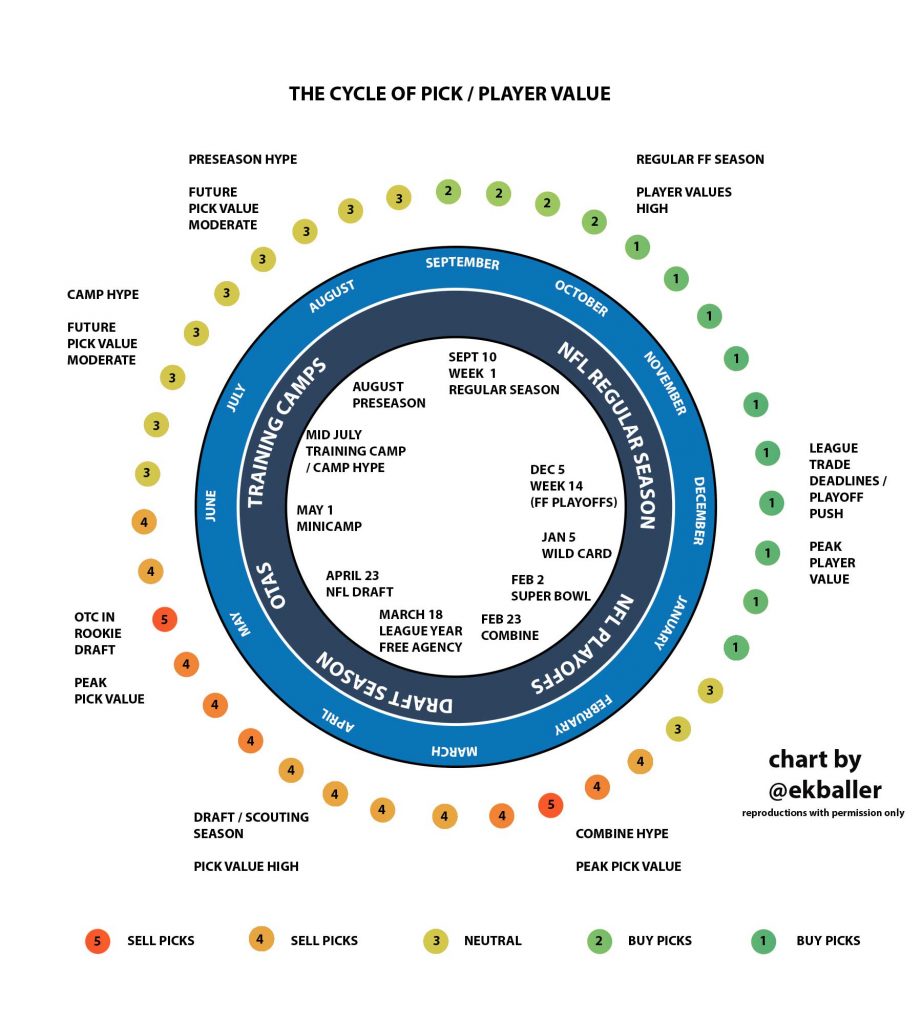
- Do: Start your rebuild during the season, before the trade deadline.
- You’ll get the best value for your pieces from contenders making a push
- Do: Be willing to trade anyone
- Hanging on to the wrong players can hinder your rebuild by preventing you from getting the high picks you need
- Assets can decline in value quickly
- Don’t: Be afraid to trade away your best player.
- Saquon Barkley, CMC, DJ Moore… a team full of dead weight with one or two studs is a stuck-in-the-middle squad.
- Don’t be short-sighted
- If your team is really bad, you should be thinking two years out
- Don’t trade for running backs or older players if you’re not in contention
- Make picks, let your players develop
- Do: Get value and move on
- Don’t turn down good trade offers for your peaking studs or hold out for an overpay;
- Don’t: leave value on the draft board
- Draft the best player and trade them if they’re not a good fit for your team
- Do: Trade back and accrue future assets
- If you can trade back from your 1.04 spot to say the 1.08 and still draft a solid target while acquiring a future 2nd rounder, that’s a win in a rebuild
- Don’t: Hold on to declining assets too long
- Don’t give up value, but you also don’t want to hold on too long. Just ask anyone that held on to Lev Bell or David Johson past their peaks
- Do: Acquire second-year-away assets
- They have value to you and are devalued to your opponents (players are focused on the coming draft)
- You can pick up added value trading for these further-out-assets
Hopefully you got some useful tips from this, whether they were from me or from the threads!
As always, hit me up anytime if you have any questions, I’m @ekballer on twitter.
Did you hear the big news? The Dynasty Nerds youtube channel is up and running. Now you can see the podcast straight from the NerdHQ!! Smash that subscribe button. Sign up for the DynastyGM tool to keep that edge over your leaguemates. Manage all of your dynasty teams, use the trade calculator, and we just added a player shares tool so you can see all players you roster in one place. Try it here for free.

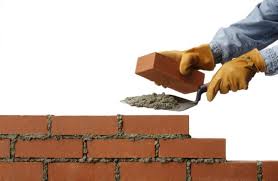







2 Responses
$th yr Dynasty player. Great Article. Reinforced a lot of things I had to learn the hard way. Wish I had this article 4 yrs ago. Am printing this article out and posting it in Chapter 1 of my note book.
Thanks man! Glad it was helpful